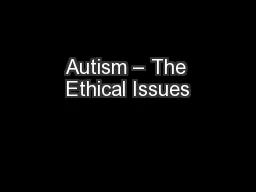

Tim Cadman PhD Introduction Aim to introduce the e thical social and philosophical issues Overview Ethical issues Theoretical background Medical vs Social conceptions of autism Human flourishing ID: 323430
Download Presentation The PPT/PDF document "Autism – The Ethical Issues" is the property of its rightful owner. Permission is granted to download and print the materials on this web site for personal, non-commercial use only, and to display it on your personal computer provided you do not modify the materials and that you retain all copyright notices contained in the materials. By downloading content from our website, you accept the terms of this agreement.
Slide1
Autism – The Ethical Issues
Tim Cadman, PhDSlide2
Introduction
Aim:
to introduce the
e
thical, social and philosophical issues
Overview:
Ethical issues
Theoretical background
Medical
vs
Social conceptions of autism
Human flourishing
Practical questions
Choosing non-autistic children
Behavioural interventions
Resource allocation
ConclusionsSlide3
What are the ethical issues?
Practical:
Development of technology to choose non-autistic children
(antenatal screening, selective implantation,
termination)
Acceptability of certain behavioural interventions
Decisions about the allocation of resources
Slide4
What are the ethical issues?
Theoretical background
Conceptualisation of autism (disorder
vs
distinct cognitive style)
Human
flourishing
and the
quality of life of autisticsSlide5
Theoretical issues 1: Medical
vs
Social
Conception of Autism
Medical model of disability
Still dominant model in some quarters
To be
disabled is to be impaired in a way which inherently limits one’s
functioning
Disability is a ‘problem’ which lies with the affected person
It is a ‘harmed condition’Slide6
Theoretical issues 1: Medical vs
Social
Conception of Autism
Social model of
disability
Acknowledgement of differences from the norm
Impairment ≠ disability
Impairments disabling only because of circumstances of society (e.g.
Achondroplasia
)
“Disability is something imposed on top of our impairments by the way we are unnecessarily isolated and excluded from full participation in society. Disabled people are therefore an oppressed group in society” (UPIAS)Slide7
Theoretical issues 1: Medical vs
Social
Conception of A
utism
Medical
Autism as a disorder (“ASD”)
Autism as inherently impairing
Treatment and cure
Social
Autism as a distinct cognitive style
Difficulties caused by attitudes and structures of society
Autism analogous to ethnicity or sexualitySlide8
Theoretical issues 1: Medical vs
Social
Conception of Autism
Conclusion
Neither view is satisfactory
More nuanced position required for autism: cluster of different properties
Social explanation persuasive for some difficulties, but not all
.
However, useful for debate to draw this distinctionSlide9
Theoretical issues 2: Human flourishing
What does it mean for a life to go well for the person living it?
Objective
Certain
things are good or bad for a person regardless of their attitudes to those
things
E.g. safety
and security, friendship, sexual relationships, freedom to pursue one’s interests,
knowledge, work, leisure.
Overly paternalistic?
Subjective
Experiential account
Desire-satisfaction accountSlide10
Theoretical issues 2: Human flourishing
Theory of well-being affects judgements about quality of life of autistic people.
Example 1
: Intellectual disability
Objective and subjective accounts conflict
Example 2
: Friendship
Objective and subjective accounts may conflict
However, many people with autism have unsatisfied desires for friendship – accounts can coincideSlide11
Practical issues 1: Choosing non-autistic children
Arguments in opposition to technology
Strong opposition from sections of autistic community
Arguments from social model:
mislocates
problem
Narrow conception of flourishing
Discrimination: implication that autistic lives have less valueSlide12
Practical issues 1: Choosing non-autistic children
Arguments in favour of technology
Reproductive autonomy
Genuine concern about quality of life
Procreative beneficence
Balancing
autonomy with concerns about social harmSlide13
Practical issues 2: Behavioural Interventions
Are certain behavioural interventions harmful?
E.g. interventions designed to reduce hand-flapping or encourage
eye contact.
These could cause anxiety and distress
Particular worry as children aren’t able to consent to these
Social model argues that there is nothing wrong with these
behaviours
Interventions should focus on improving well-being
Attitudes in society need to be tackled.Slide14
Practical issues 3: Allocation of Resources
Where should resources be targeted?
Research into causes and early identification
Providing support and enacting social change
Issue of intergenerational justice
Decision making process needs to be democratic
Include views of those with autism, philosophers
and ethicists
,
carers, policy makers, scientists and the
publicSlide15
Conclusions
Complex theoretical and practical
issues
Important to note diversity of
opinion within autistic community
Agreement may never be reached
Key is to involve range of opinion in debate